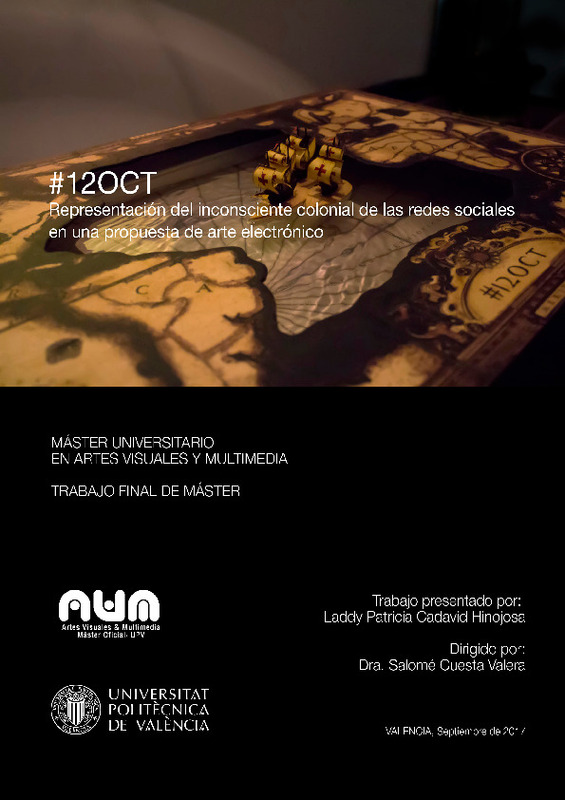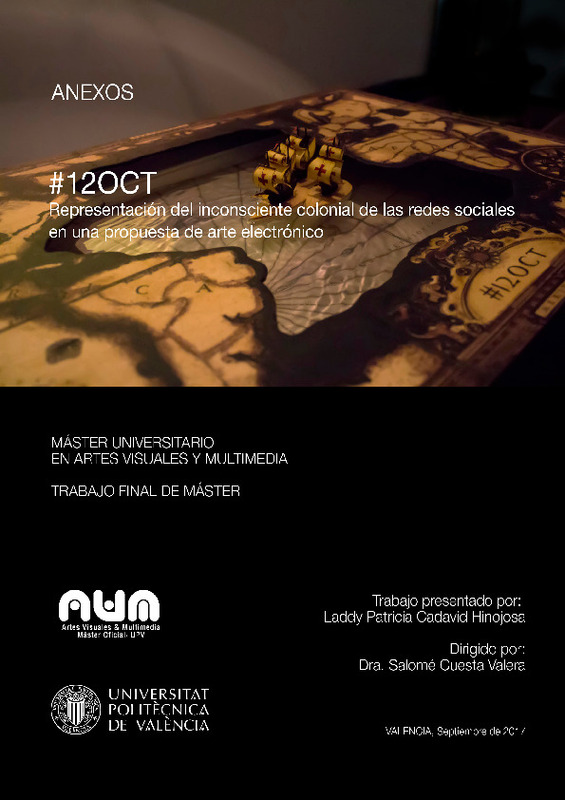JavaScript is disabled for your browser. Some features of this site may not work without it.
Buscar en RiuNet
Listar
Mi cuenta
Estadísticas
Ayuda RiuNet
Admin. UPV
#12OCT. Representación del inconsciente colonial de las redes sociales en una propuesta de arte electrónico
Mostrar el registro sencillo del ítem
Ficheros en el ítem
| dc.contributor.advisor | Cuesta Valera, María Salomé
|
es_ES |
| dc.contributor.author | Cadavid Hinojosa, Laddy Patricia
|
es_ES |
| dc.date.accessioned | 2017-10-23T07:49:19Z | |
| dc.date.available | 2017-10-23T07:49:19Z | |
| dc.date.created | 2017-09-26 | |
| dc.date.issued | 2017-10-23 | es_ES |
| dc.identifier.uri | http://hdl.handle.net/10251/89817 | |
| dc.description.abstract | This research work, reflects about certain aspects of the past and present of the colonial panorama in Hispanic-America and the Spanish state through a critical approach of the different meanings that have been given to the paradigmatic date of October 12, 1492; held today, - as a result of this controversy - with different names and different ways in colonized countries and the Spanish territory. The developed practical project, consists in an interactive installation (cataloged in a guidance way as "Day Specific") that makes use of simple and open devices to the public, using social networks like a collective thinking sensor on both sides of the Atlantic. It utilizes the visualization of data provided by Twitter and the traditional cartographic representation of the surface of the earth, world map that includes part of America, Europe and Africa; inside it three ships are moving in a container with water, they are of proportional size symbolizing the caravels led by Christopher Columbus, the movement is due by the water flow that changes according to the reading of the data in real time generated by the search of specific hashtags related to the different links that come from The #12OCT tag on the social network. In this way, the collective thinking is reflected in the use of hashtags on the web, the movement of the ships due to the water flows allows to observe the cultural depth of the approximation of this date on both continents. Influenced by decolonial thinking, this representation, confronts and make faces to different perspectives on one same event, taking as reference Post-Internet artistic practices that use the information flow of social networks as a medium of social communication for creation, electronic art and different manifestations linked to points that converge in the theoretical reflection. | es_ES |
| dc.description.abstract | Este trabajo reflexiona sobre determinados aspectos del pasado y presente del panorama colonial en Hispanoamérica y el Estado español, mediante un enfoque critico de los diferentes significados que se le han dado a la fecha paradigmática del 12 de octubre de 1492; hoy en día celebrada -como resultado de esta controversia- con nombres distintos y de diferentes maneras tanto en los países de las excolonias como en el territorio español. El proyecto práctico desarrollado, consta de una instalación interactiva (catalogada de forma orientativa como ¿Day Specific¿) que hace uso de dispositivos sencillos y abiertos al público, utilizando las redes sociales como sensor del pensamiento colectivo en ambos lados del Atlántico. La instalación, emplea la visualización de datos obtenidos en Twitter y la representación cartográfica tradicional de la superficie de la tierra, mapamundi que comprende parte de América, Europa y África; en ella, tres barcos se desplazan en un recipiente con agua, son de tamaño proporcional simbolizando las carabelas dirigidas por Colón que se trasladan de un continente a otro gracias a las corrientes de agua que varían en función de la lectura de los datos en tiempo real generados por la búsqueda de hashtags específicos relacionados con los diferentes vínculos que se desprenden de la etiqueta #12OCT en la red social. De esta manera, el pensamiento colectivo se refleja en el uso de etiquetas en la red, el movimiento de las embarcaciones por el flujo de las corrientes de agua permite reflexionar sobre el calado cultural de esta fecha tan señalada en ambos continentes. Influenciada por el pensamiento decolonial, esta representación visibiliza y confronta las diferentes perspectivas ante un mismo acontecimiento y su repercusión en la actualidad, tomando como referencia prácticas artísticas Post-Internet que utilizan el flujo de información de las redes sociales como un medio de comunicación social para la creación, el arte electrónico y las diferentes manifestaciones ligadas a los puntos que confluyen en la reflexión teórica. | es_ES |
| dc.language | Español | es_ES |
| dc.publisher | Universitat Politècnica de València | es_ES |
| dc.rights | Reconocimiento - No comercial - Sin obra derivada (by-nc-nd) | es_ES |
| dc.subject | Postcolonialism | es_ES |
| dc.subject | Data visualization | es_ES |
| dc.subject | Decolonial thinking | es_ES |
| dc.subject | Interactive installation | es_ES |
| dc.subject | es_ES | |
| dc.subject | Arduino | es_ES |
| dc.subject | Processing | es_ES |
| dc.subject | Raspberry Pi | es_ES |
| dc.subject | Electronic Art | es_ES |
| dc.subject | World Map | es_ES |
| dc.subject | Social Networks | es_ES |
| dc.subject | Post-Internet Art | es_ES |
| dc.subject | Parsing | es_ES |
| dc.subject | Day Specific art | es_ES |
| dc.subject | Eurocentrism | es_ES |
| dc.subject | Pensamiento decolonial | es_ES |
| dc.subject | Instalación interactiva | es_ES |
| dc.subject | Arte electrónico | es_ES |
| dc.subject | Mapamundi | es_ES |
| dc.subject | Redes Sociales | es_ES |
| dc.subject | Arte Post-Internet | es_ES |
| dc.subject | Eurocentrismo | es_ES |
| dc.subject | Visualización de datos | es_ES |
| dc.subject | Poscolonialismo | es_ES |
| dc.subject.classification | ESCULTURA | es_ES |
| dc.subject.other | Máster Universitario en Artes Visuales y Multimedia-Màster Universitari en Arts Visuals i Multimèdia | es_ES |
| dc.title | #12OCT. Representación del inconsciente colonial de las redes sociales en una propuesta de arte electrónico | es_ES |
| dc.type | Tesis de máster | es_ES |
| dc.rights.accessRights | Abierto | es_ES |
| dc.contributor.affiliation | Universitat Politècnica de València. Departamento de Escultura - Departament d'Escultura | es_ES |
| dc.description.bibliographicCitation | Cadavid Hinojosa, LP. (2017). #12OCT. Representación del inconsciente colonial de las redes sociales en una propuesta de arte electrónico. http://hdl.handle.net/10251/89817 | es_ES |
| dc.description.accrualMethod | TFGM | es_ES |
| dc.relation.pasarela | TFGM\73206 | es_ES |







